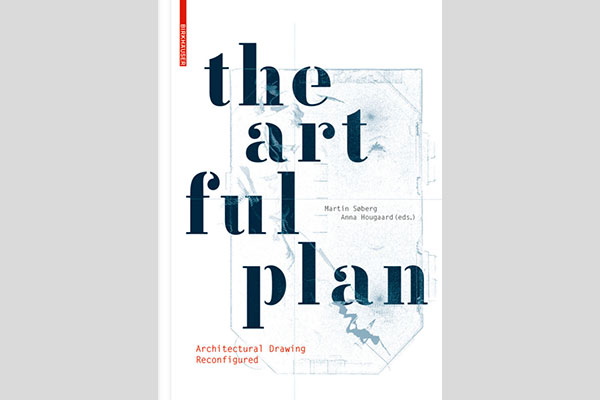
Editors: Martin Søberg and Anna Hougaard (Birkhäuser, 2020)
Architectural representations are more than just visual aids—they are the foundational blueprints for the built environment, embodying the visions of city-builders, and specifications of designers. As powerful tools for communication, they also serve to influence decisions of the public and municipal officials, while serving as tools of exploration, and creative expression for architects. Of the many representation types used daily, perhaps none is more understated and powerful than the architectural plan drawing.
Often referred to simply as a “plan,” this drawing type is a two-dimensional representation of a building or space as seen from “above”. A foundational drawing aid to the real estate industry, it typically depicts the layout, dimensions, and spatial relationships of rooms, corridors, and other architectural elements within a building. As such, they are also the basis of regulatory compliance: detailed plan drawings are a part of most if not all, permit application processes.
At a larger scale, plan views are the basis of urban cartography—from zoning maps to the countless mapping apps we use every day. In this way, plans diagram social relationships and clearly visualize power relationships and political agendas.
Unfortunately, despite their dominance and biases, plans are rarely scrutinized. This makes books on the subject—such as The Artful Plan: Architectural Drawing Reconfigured—valuable resources. Edited by Martin Søberg and Anna Hougaard the book offers an important and refreshing perspective on the role and significance of architectural drawing in contemporary art and architectural practices. Its well-curated collection of essays, case studies, and visual examples, offers insights into the evolving nature of architectural plans and their impact on the design process and products.
At its core, “The Artful Plan” aspires to acknowledge, yet challenge, traditional notions of architectural plan as merely a means of technical communication. The book is divided into three parts, accordingly, with carefully curated contributions from a diverse range of architects, artists and educators offering unique insights into this “reconfigured” approach to architectural plan.
The first part—The Conventional Plan, Its Formation and Reconfiguration—brings together essays that focus on the history of the plan, its role in current practice as a drawing convention, as well as its potential as a catalyst for new architectural practices and ways of thinking about space.
The second part—Point Clouds, Chance Operations, and the Disappearance of the Plan—speaks to the rise of digital media within the building and design disciplines. This collection of essays opens the door to questioning the relevance of the plan drawings in the face of the many new representation technologies like Light Detection and Ranging (LiDar) and other scanning techniques.
The final and third part—The Plan and the Expanded Field of Architectural Drawing—focuses on new methods of approaching architectural drawing in light of our “hybrid, post-digital condition” that has greatly expanded the means and methods of architectural drawing. It argues for a more expansive understanding that embraces drawing as a creative tool for exploration, expression, and critical inquiry.
One of the book’s strengths lies in its exploration of various drawing techniques, media, approaches and ways of thinking about the plan and its role in shaping architectural ideas. Through rich visual examples and accompanying analyses, readers gain a deeper appreciation for the nuanced ways in which different drawing methods can inform design thinking and communication.
Moreover, The Artful Plan addresses timely topics such as the integration of computational and digital tools into the drawing process. It examines how advancements in technology are not only expanding the possibilities of architectural representation but also challenging traditional boundaries between plan drawings and making.
The book also underscores the importance of drawing as a form of critical inquiry and speculation. Several essays delve into the role of drawing in architectural research and practice, emphasizing its capacity to provoke new questions, challenge assumptions, and envision alternative futures. In doing so, “The Artful Plan” highlights the vital role that drawing plays in pushing the boundaries of architectural discourse and innovation.
While “The Artful Plan” presents a compelling argument for rethinking architectural drawing, it also acknowledges the ongoing tensions and debates within the discipline. Discussions around the relationship between representation and reality, the authenticity of hand-drawing versus digital rendering, and the democratization of design tools add depth to the book’s exploration of contemporary drawing practices.
Given its dominance as a mode of representation integrated into permits and all types of urban planning documents, I believe the book would have been strengthened further by exploring the plan and its “reconfiguration” at the larger scales of the urban environment. It would have been interesting, for example, to include pieces that examine what effects a more critical stance on the plan as a dominant drawing type might have on the city at large. Books like Stephen Graham’s Vertical: The City from Satellites to Bunkers have done well to open the door to the limitations of the plan drawing and its understanding of the contemporary city, and it would have added a wonderful layer to the many strengths of the book’s content.
Ultimately, however, The Artful Plan: Architectural Drawing Reconfigured offers a thought-provoking examination of the evolving role of drawing in architectural practice and theory. By presenting a diverse array of perspectives and examples, the book inspires readers to reconsider the possibilities of architectural representation in the digital age. It is a must-read for architects, designers, educators, and anyone interested in the intersection of representation, art, technology, and architecture.
***
For more information on The Artful Plan: Architectural Drawing Reconfigured visit the Birkhäuser website. You can also sample the book via ISSUU here.
**
Erick Villagomez is the Editor-in-Chief at Spacing Vancouver and teaches within the UBC’s School of Community and Regional and KPU’s Wilson School of Design.

